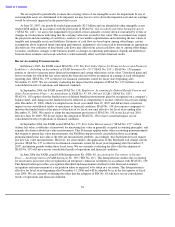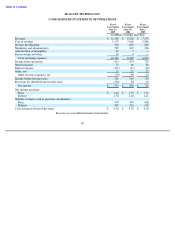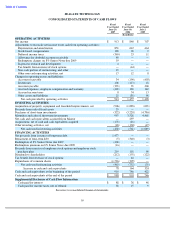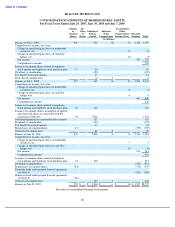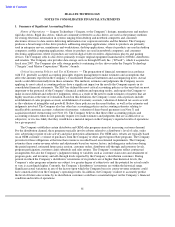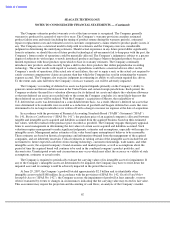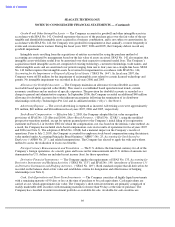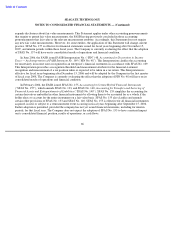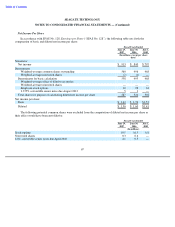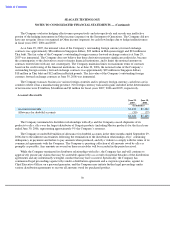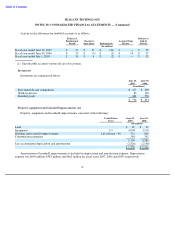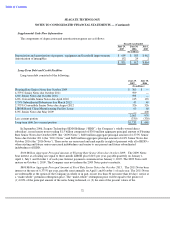Seagate 2006 Annual Report Download - page 67
Download and view the complete annual report
Please find page 67 of the 2006 Seagate annual report below. You can navigate through the pages in the report by either clicking on the pages listed below, or by using the keyword search tool below to find specific information within the annual report.
Table of Contents
SEAGATE TECHNOLOGY
NOTES TO CONSOLIDATED FINANCIAL STATEMENTS — (Continued)
Goodwill and Other Intangibles Assets — The Company accounts for goodwill and other intangible assets in
accordance with SFAS No. 142. Goodwill represents the excess of the purchase price over the fair value of the net
tangible and identifiable intangible assets acquired in a business combination, and is not subject to amortization. In
accordance with SFAS No. 142, the Company tests goodwill for impairment at least annually, or more frequently if
events and circumstances warrant. During the fiscal years 2007, 2006 and 2005, the Company did not record any
goodwill impairment.
Intangible assets resulting from the acquisitions of entities accounted for using the purchase method of
accounting are estimated by management based on the fair value of assets received. SFAS No. 142 also requires that
intangible assets with finite useful lives be amortized over their respective estimated useful lives. The Company’s
acquisition-related intangible assets are comprised of existing technology, customer relationships, trade names, and
other intangible assets and are amortized over periods ranging from one to four years on a straight-line basis. SFAS
No. 142 further requires that intangible assets be reviewed for impairment in accordance with SFAS No. 144,
Accounting for the Impairment or Disposal of Long
-Lived Assets (“SFAS No. 144”). In fiscal year 2007, the
Company wrote off $8 million for the impairment of an intangible asset related to certain licensed technology and
patents. No intangible impairment was recorded in fiscal years 2006 and 2005.
Allowances for Doubtful Accounts — The Company maintains an allowance for uncollectible accounts
receivable based upon expected collectibility. This reserve is established based upon historical trends, current
economic conditions and an analysis of specific exposures. The provision for doubtful accounts is recorded as a
charge to general and administrative expense. In September 2006, the Company recorded an additional $40 million
allowance for doubtful accounts due to the inherent uncertainties following the termination of its distributor
relationships with eSys Technologies Pte. Ltd. and its affiliated entities (“eSys”). See Note 2.
Advertising Expense — The cost of advertising is expensed as incurred. Advertising costs were approximately
$51 million, $40 million and $26 million in fiscal years 2007, 2006 and 2005, respectively.
Stock-Based Compensation — Effective July 2, 2005, the Company adopted the fair value recognition
provisions of SFAS No. 123 (Revised 2004), Share-Based Payment , (“SFAS No. 123(R)”), using the modified-
prospective-transition method, except for options granted prior to the Company’s initial filing of its registration
statement on Form S-1
in October 2002 for which the compensation cost was based on the intrinsic value method. As
a result, the Company has included stock-based compensation costs in its results of operations for fiscal years 2007
and 2006 (see Note 3). The adoption of SFAS No. 123(R) had a material impact on the Company’s results of
operations. Prior to July 2, 2005, the Company accounted for employee stock-based compensation using the intrinsic
value method under Accounting Principles Board Opinion (“APBO”) No. 25, Accounting for Stock Issued to
Employees
(“APBO No. 25”), and related interpretations. The Company has elected to apply the with and without
method to assess the realization of excess tax benefits.
Foreign Currency Remeasurement and Translation — The U.S. dollar is the functional currency for all of the
Company’s foreign operations. As a result, gains and losses on the remeasurement into U.S. dollars of amounts not
denominated in U.S. dollars are included in net income (loss) for those operations.
Derivative Financial Instruments — The Company applies the requirements of SFAS No. 133, Accounting for
Derivative Instruments and Hedging Activities
(“SFAS No. 133”) and SFAS No. 149, Amendment of Statement 133
on Derivative Instruments and Hedging Activities , (“SFAS No. 149”). Both standards require that all derivatives be
recorded on the balance sheet at fair value and establishes criteria for designation and effectiveness of hedging
relationships (see Note 2).
Cash, Cash Equivalents and Short-Term Investments — The Company considers all highly liquid investments
with a remaining maturity of 90 days or less at the time of purchase to be cash equivalents. Cash equivalents are
carried at cost, which approximates fair value. The Company’s short-term investments are primarily comprised of
readily marketable debt securities with remaining maturities of more than 90 days at the time of purchase. The
Company has classified its entire investment portfolio as available-for-sale. Available-for-sale securities are
64


